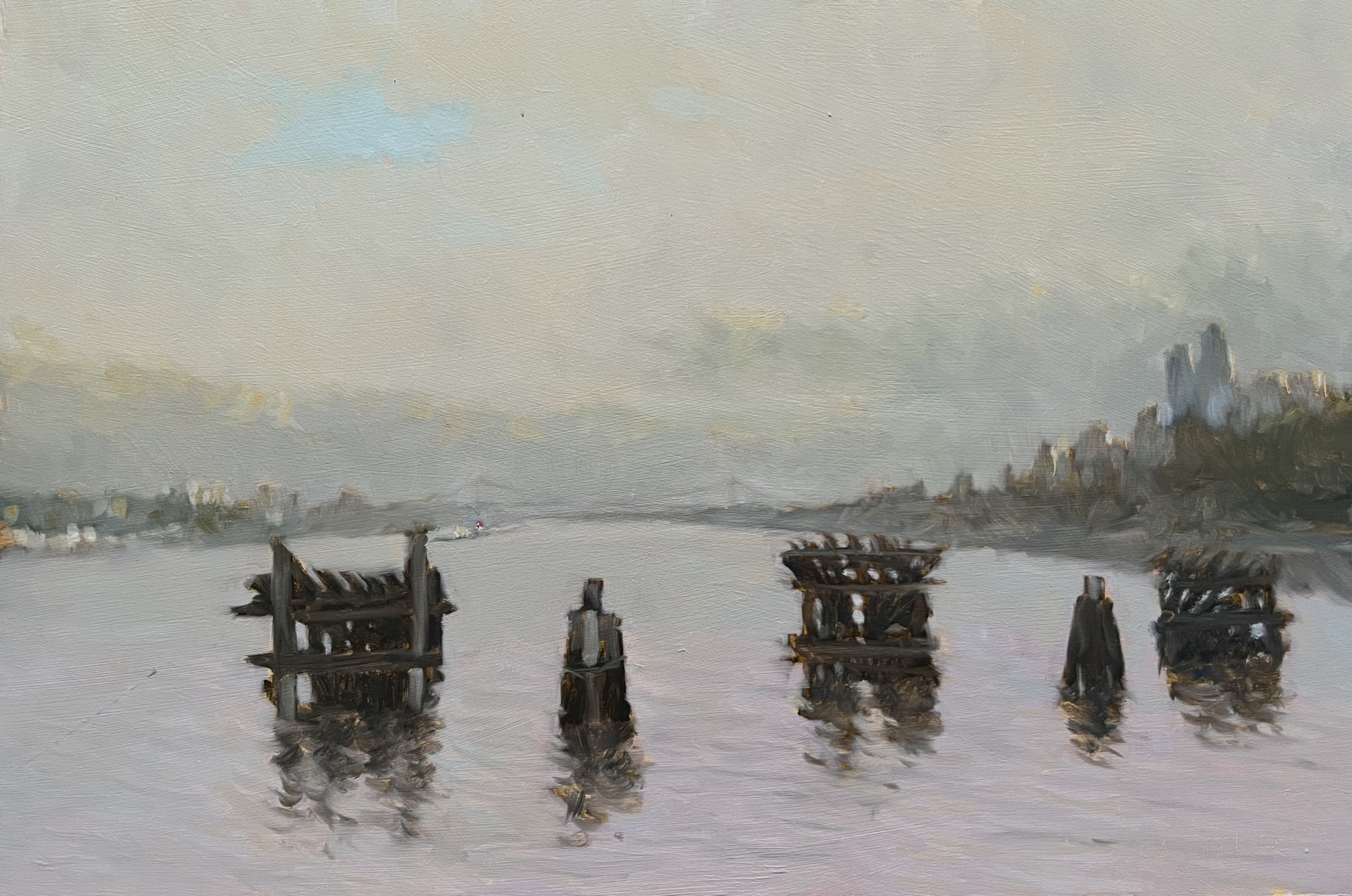
Transformation
By Robert Beck
The farthest I can get from the hard and fast of Manhattan is the wharf that sticks out into the Hudson near the 79th Street Boat Basin. It’s more than space and quiet; it’s a frame of reference. When I look north toward the sliver of the George Washington Bridge, I see the young boy peering out the side window of my father’s ’50 Ford as we cross from New Jersey. We drove down the West Side along the water, passing the rail facilities, then the stacks and superstructures of ocean liners sticking up above their piers, on our way to the Battery and Brooklyn for Sunday with the grandparents.
This stretch of shoreline is different from what it was then, just as it was different before that. Before Robert Moses, Emery Roth, Fredrick Olmsted, or Vanderbilt and Edison. Before it was New York, or even Nieuw Amsterdam.
From out on the water, looking upstream at the larger contours of the river and the outcroppings and trees on each side, it’s easy to let the buildings dissolve and envision a historic line back to the Lenape and their forebears. Much of that history has been obliterated in the rush for more and bigger. Anything worth remembering you can see behind glass in the museum, right? Here? I don’t know what was here.
Some city changes are relatively gradual, like the growth of the Upper West Side over the past couple of centuries. Some remakings bloom at a condensed pace, as when expansive rail yards and shore facilities appeared in the age of rail, then surrendered to new and different ways as that age succumbed to automobiles and planes. Neighbors and neighborhoods can suddenly vanish in service of the latest ideas and powers, like Lincoln Center rising on the Hill. When time is up, whole histories fall into the churn.
This part of the river is an estuary. It has a tide that has been rising and falling five feet twice a day for millennia. I don’t know what these wood structures in the water are—they could be deflective bulwarks or bridge pilings—but they are of a time. Of the city and its clock.
Out in the stream of the river, I am in the hands of nature, and there is only now. The sky, the water, the breeze, and that tide. But changes are coming.
To contact Robert Beck or see more of his work, visit robertbeck.net
Read all of our Weekend Columns here.










The correct spelling is Emery, not Emory Roth.
Thanks
My outrigger canoe club based at Pier 96 refers to those wood structures as “ice breakers.” Ice breakers usually refer to ships, but assuming that those wooden structures were placed there also to break the ice?
I have chills as I type this. Such effective and evocative writing coupled with a really lovely painting. You say some really important things in the essay, especially about the “rush for more and bigger”. There are so many of us who want to slow things down and have our environment BE the museum, but we cannot. We are too disparate as a community and have lost our mooring.
Absolutely beautiful painting and writing. I find myself just staring at that view. Thank you!
The painting is so evocative. It manages to be restful while suggesting motion.
This brings up my memory of seeing the Normandie lying on its side after a fire on February 9, 1942. It was the largest and most luxurious ocean liner on the seas at that time and was being converted to military use.
Marvin: I remember my father showing me a photo of the Normandie that he took, as it lie on its side, having capsized from all the water that had been poured on it in an effort to stop the fire. Holder of the Blue Riband at the time, I think. France had been occupied, and the ship was commandeered by the US to be used as a troop transport. A lot of the fine decoration, including some stunning lacquer panels, was removed, and obstensibly stored, but the ship was lost to the construction fire.
Robert Beck’s beautifully written article’s, featuring his stunning paintings, are a unique and very special gift to those of us who share a love of the UWS. Thank you.
A lump in my throat as I read these words out loud to my partner. We live on. W 73 and enjoyed walking to the boathouse restaurant and have read many articles about the boat basin, many written by the folks who lived on those boats and the continuing articles about what is planned for the new basin. When the design is finally agreed upon we surely hope that those folks will come back to a wonderful way of live that they enjoyed. May it be rebuilt as quickly as it came down .
We love that spot and hope that whatever they are planning for the basin keeps it low and simple.
Good heavens, Mr. Beck. Just beautiful. And that little patch of blue. Thank you for your evocative works and for your deep appreciation of our shared community. When I’ve (mostly) surrendered to living in NYC and for a long time now, the Upper West Side, I let Riverside Park and the Hudson River become my back yard. And deeply personal. Thank you for giving me the opportunity to feel known and cherished.
Thank you for the evocative painting & essay. I walked up in Riverside Park from 84th to 95th Street this afternoon; I was amazed by the lushness & greenness of the park. Walking here for so many decades, I’ve never seen the park more thriving.
Anyone who wants to know everything about what it was like before Westerners came should read “Mannahatta” by Eric W. Snderson.